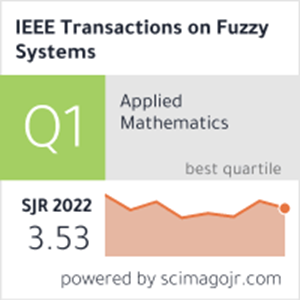Multiview Unsupervised Representation Learning via Integration of Fuzzy Rules and Graph-Based Adaptive Regularization
IF 11.9
1区 计算机科学
Q1 COMPUTER SCIENCE, ARTIFICIAL INTELLIGENCE
引用次数: 0
Abstract
With the rapid advancement of data acquisition technologies, multiview data have been widely applied in fields such as social networks, computer vision, and natural language processing. Multiview data typically contain information arising from different views or sensors, offering more perspectives for observation. The multiview nature also brings challenges, such as high dimensionality, noise, heterogeneity, and redundancy. Particularly, in scenarios with limited labeled data, traditional single-view learning methods often struggle to handle these complex issues. To address this, this article proposes an unsupervised multiview learning framework that integrates Takagi–Sugeno–Kang fuzzy systems and graph-based adaptive regularization (MvTSK-GAR) to handle the heterogeneity and redundancy in multiview data effectively. Specifically, this article first captures the uncertainty in multiview data through fuzzy rules and models the structural relationships between the data using graph-based adaptive regularization. The framework does not rely on a large amount of labeled data. Instead, it integrates complementary information coming from different views to automatically mine latent patterns, thus generating more accurate and stable data representations. Experimental results demonstrate that the proposed framework performs well in various real-world applications, particularly excelling in high-dimensional data processing and noise reduction. Good performance in multiple publicly available datasets validates the effectiveness of our approach.基于模糊规则和基于图的自适应正则化的多视图无监督表示学习
随着数据采集技术的飞速发展,多视图数据在社交网络、计算机视觉、自然语言处理等领域得到了广泛的应用。多视图数据通常包含来自不同视图或传感器的信息,为观察提供了更多的视角。多视图的特性也带来了高维、噪声、异构和冗余等挑战。特别是在标签数据有限的情况下,传统的单视图学习方法往往难以处理这些复杂的问题。为了解决这一问题,本文提出了一种无监督多视图学习框架,该框架将Takagi-Sugeno-Kang模糊系统和基于图的自适应正则化(MvTSK-GAR)相结合,有效地处理多视图数据中的异构性和冗余性。具体而言,本文首先通过模糊规则捕获多视图数据中的不确定性,并使用基于图的自适应正则化方法对数据之间的结构关系进行建模。该框架不依赖于大量的标记数据。相反,它集成来自不同视图的互补信息,自动挖掘潜在模式,从而生成更准确和稳定的数据表示。实验结果表明,该框架在各种实际应用中表现良好,特别是在高维数据处理和降噪方面表现突出。在多个公开可用数据集上的良好性能验证了我们方法的有效性。
本文章由计算机程序翻译,如有差异,请以英文原文为准。
求助全文
约1分钟内获得全文
求助全文
来源期刊

IEEE Transactions on Fuzzy Systems
工程技术-工程:电子与电气
CiteScore
20.50
自引率
13.40%
发文量
517
审稿时长
3.0 months
期刊介绍:
The IEEE Transactions on Fuzzy Systems is a scholarly journal that focuses on the theory, design, and application of fuzzy systems. It aims to publish high-quality technical papers that contribute significant technical knowledge and exploratory developments in the field of fuzzy systems. The journal particularly emphasizes engineering systems and scientific applications. In addition to research articles, the Transactions also includes a letters section featuring current information, comments, and rebuttals related to published papers.
 求助内容:
求助内容: 应助结果提醒方式:
应助结果提醒方式:


